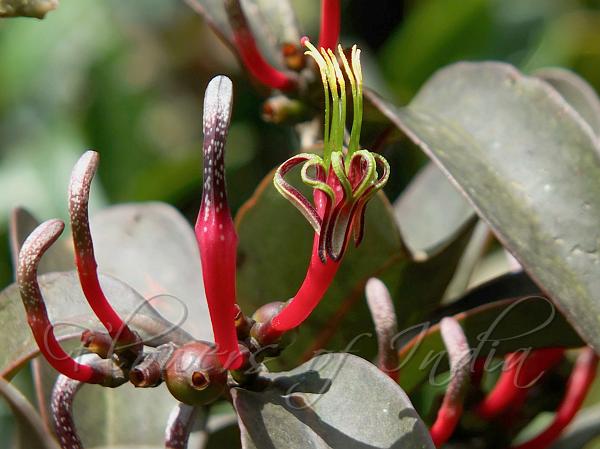|
| White-Dotted Red Mistletoe |
|

|

| File size | 299545 |
| Original date | 10/26/14 11:53 AM |
| Resolution | 2048 x 1536 |
| Flash | Flash did not fire, auto |
| Focal length | 142.7mm |
| Exposure time | 1/250s |
| Aperture | 5.6 |
| Focus Distance | |
| Metering Mode | Multi-segment |
| Camera make | FUJIFILM |
| Camera model | X-S1 |
| Sensor type | OneChipColorArea |
|
|
|
|
Photo: |
Botanical name: Macrosolen pseudopsilantha Family: Loranthaceae (Mistletoe family)
Synonyms: Elytranthe pseudopsilantha
Synonyms: Elytranthe pseudopsilantha
White-Dotted Red Mistletoe is a tree-dwelling
parasitic shrub, with branches round or winged; wings of one internode
alternating with those of one above and below. It is closely similar to
Honeysuckle Mistletoe. Leaves
are oppositely arranged, broadly ovate-elliptic, almost decurrent to
base of leaf-stalks, thickened and curled along margins, blunt at tip,
9-13 x 4-6.5 cm, crustaceous; lateral nerves 4 or 5 pairs; leaf-stalks
4-7 mm long. Flowers are borne in leaf-axils, in clusters carried on
flower-cluster-stalks 2 or 3 in each axil, almost round, 5-7 mm long,
each 3- or 4-flowered, short; each subtended by 3 or 4 whorls of
large ovate-pointed bracts; flower buds curved, spoon-shaped, 1.8-2.2
cm long. Flowers are 3-4 cm long; bract and bracteoles equal, ovate or
round, 4-4.5 x 3.5-4 mm. Calyculus tubular, flat with wavy margin; tube
split unilaterally 2-3 mm long. Petals are 6, united at base; tube
round, equally split up to one-third to half the length, densely
white-dotted, 1.8-2.2 cm long; lobes 6, linear or elliptic, reflexed
and coiled, ribbed, 1.2-1.8 cm long. Stamens are 6, recurved; filaments
6-8 mm long; anthers linear, 4-locular, 2-2.5 mm long. Ovary is almost
spherical; style 4-gonous; stigma almost spherical, lobed. Fruits are
broadly ellipsoid-ovoid, smooth, hairless, crowned by persistent
tubular calyculus, 9-11 x 7-8 mm. White-Dotted Red Mistletoe is found
in evergreen forests above 1000 m altitude on a variety of hosts, in
Kerala and Tamil Nadu. Flowering: November-February.
| Identification credit: Suranjan Fernando, Navendu Pagé | Photographed in Nilgiri Biosphere Reserve. |
• Is this flower misidentified? If yes,